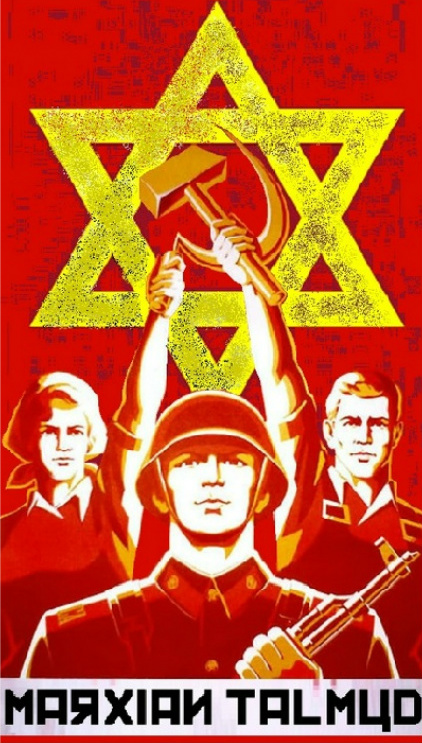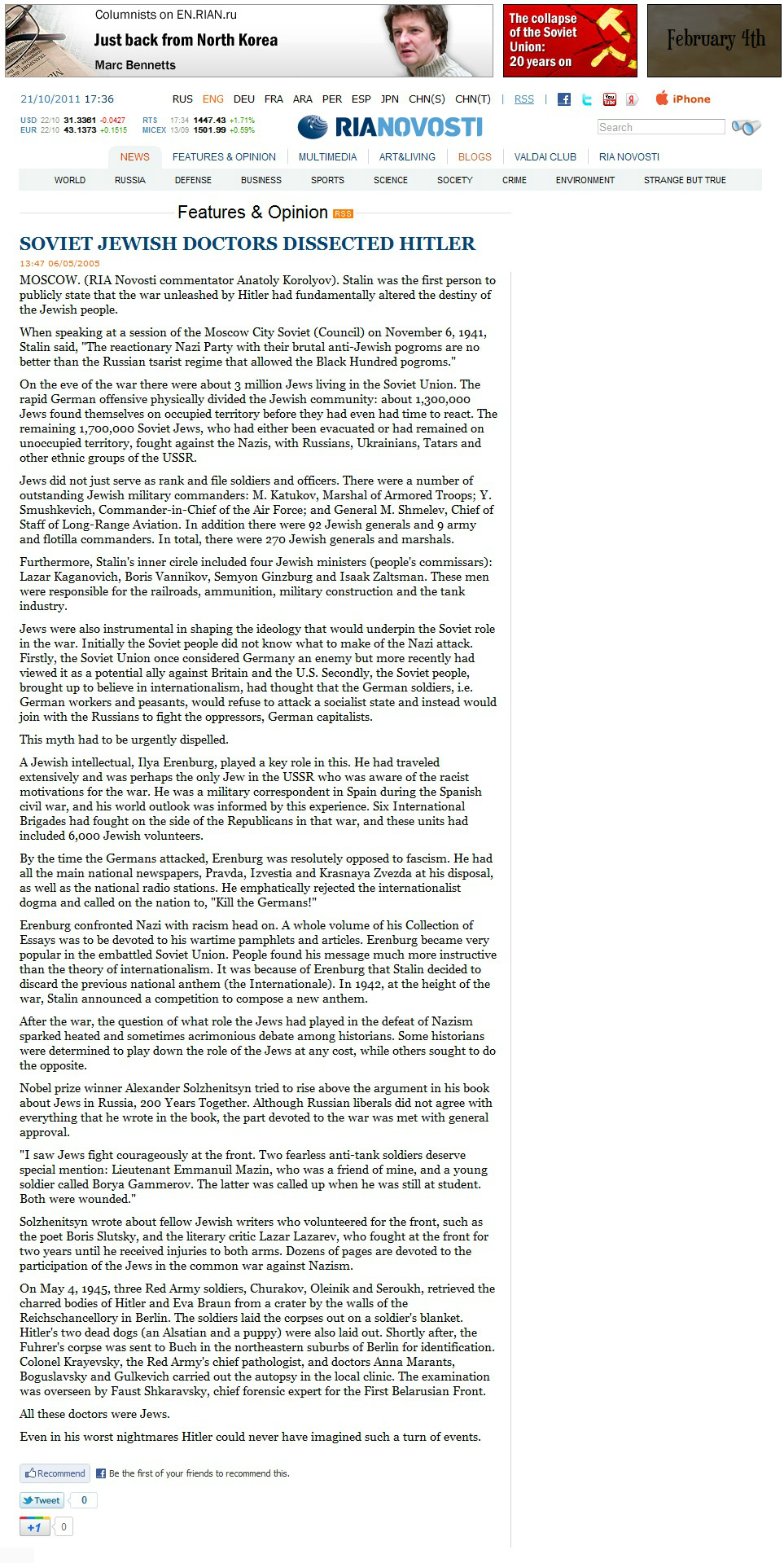When speaking at a
session of the
Moscow City Soviet
(Council) on
November 6, 1941,
Stalin said, "The
reactionary Nazi
Party with their
brutal anti-Jewish
pogroms are no
better than the
Russian tsarist
regime that allowed
the Black Hundred
pogroms."
On the eve of
the war there
were about 3
million Jews
living in the
Soviet Union.
The rapid German
offensive
physically
divided the
Jewish
community: about
1,300,000 Jews
found themselves
on occupied
territory before
they had even
had time to
react. The
remaining
1,700,000 Soviet
Jews, who had
either been
evacuated or had
remained on
unoccupied
territory,
fought against
the Nazis, with
Russians,
Ukrainians,
Tatars and other
ethnic groups of
the USSR.
Jews did not
just serve as
rank and file
soldiers and
officers. There
were a number of
outstanding
Jewish military
commanders: M.
Katukov, Marshal
of Armored
Troops; Y.
Smushkevich,
Commander-in-Chief
of the Air
Force; and
General M.
Shmelev, Chief
of Staff of
Long-Range
Aviation. In
addition there
were 92 Jewish
generals and 9
army and
flotilla
commanders. In
total, there
were 270 Jewish
generals and
marshals.
Furthermore, Stalin's
inner circle
included four
Jewish ministers
(people's
commissars):
Lazar
Kaganovich,
Boris Vannikov,
Semyon Ginzburg
and Isaak
Zaltsman. These
men were
responsible for
the railroads,
ammunition,
military
construction and
the tank
industry.
Jews were
also
instrumental in
shaping the
ideology that
would underpin
the Soviet role
in the war. Initially
the Soviet
people did not
know what to
make of the Nazi
attack. Firstly,
the Soviet Union
once considered
Germany an enemy
but more
recently had
viewed it as a
potential ally
against Britain
and the U.S.
Secondly, the
Soviet people,
brought up to
believe in
internationalism,
had thought that
the German
soldiers, i.e.
German workers
and peasants,
would refuse to
attack a
socialist state
and instead
would join with
the Russians to
fight the
oppressors,
German
capitalists.
This myth had to
be urgently
dispelled.
A Jewish
intellectual,
Ilya Erenburg,
played a key
role in
this. He had
traveled
extensively and
was perhaps the
only Jew in the
USSR who was
aware of the
racist
motivations for
the war. He was
a military
correspondent in
Spain during the
Spanish civil
war, and his
world outlook
was informed by
this experience.
Six
International
Brigades had
fought on the
side of the
Republicans in
that war, and
these units had
included 6,000
Jewish
volunteers.
By the time the
Germans
attacked,
Erenburg was
resolutely
opposed to
fascism. He had
all the main
national
newspapers,
Pravda, Izvestia
and Krasnaya
Zvezda at his
disposal, as
well as the
national radio
stations. He
emphatically
rejected the
internationalist
dogma and called
on the nation
to, "Kill the
Germans!"
Erenburg
confronted Nazi
with racism head
on. A whole
volume of his
Collection of
Essays was to be
devoted to his
wartime
pamphlets and
articles.
Erenburg became
very popular in
the embattled
Soviet Union.
People found his
message much
more instructive
than the theory
of
internationalism.
It was because
of Erenburg that
Stalin decided
to discard the
previous
national anthem
(the
Internationale).
In 1942, at the
height of the
war, Stalin
announced a
competition to
compose a new
anthem.
After the war,
the question of
what role the
Jews had played
in the defeat of
Nazism sparked
heated and
sometimes
acrimonious
debate among
historians. Some
historians were
determined to
play down the
role of the Jews
at any cost,
while others
sought to do the
opposite.
Nobel prize
winner Alexander
Solzhenitsyn
tried to rise
above the
argument in his
book about Jews
in Russia, 200
Years Together.
Although Russian
liberals did not
agree with
everything that
he wrote in the
book, the part
devoted to the
war was met with
general
approval.
"I saw Jews
fight
courageously at
the front. Two
fearless
anti-tank
soldiers deserve
special mention:
Lieutenant
Emmanuil Mazin,
who was a friend
of mine, and a
young soldier
called Borya
Gammerov. The
latter was
called up when
he was still at
student. Both
were wounded."
Solzhenitsyn
wrote about
fellow Jewish
writers who
volunteered for
the front, such
as the poet
Boris Slutsky,
and the literary
critic Lazar
Lazarev, who
fought at the
front for two
years until he
received
injuries to both
arms. Dozens of
pages are
devoted to the
participation of
the Jews in the
common war
against Nazism.
On May 4, 1945,
three Red Army
soldiers,
Churakov,
Oleinik and
Seroukh,
retrieved the
charred bodies
of Hitler and
Eva Braun from a
crater by the
walls of the
Reichschancellory
in Berlin. The
soldiers laid
the corpses out
on a soldier's
blanket.
Hitler's two
dead dogs (an
Alsatian and a
puppy) were also
laid out. Shortly
after, the
Fuhrer's corpse
was sent to Buch
in the
northeastern
suburbs of
Berlin for
identification. Colonel
Krayevsky, the
Red Army's chief
pathologist, and
doctors Anna
Marants,
Boguslavsky and
Gulkevich
carried out the
autopsy in the
local clinic.
The examination
was overseen by
Faust
Shkaravsky,
chief forensic
expert for the
First Belarusian
Front.
All these
doctors were
Jews.
Even in his
worst nightmares
Hitler could
never have
imagined such a
turn of events.





































